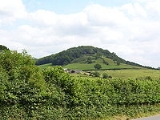
Twinhills Woods and Meadows
Encyclopedia
Twinhills Woods and Meadows is a 21.2 hectare
(52.4 acre) biological Site of Special Scientific Interest on the Monarch's Way
south of Dulcote in Somerset
, notified in 1990.
Twinhills Woods and Meadows comprise a complex of ancient
, semi-natural woodland, neutral and calcareous grassland
with associated mature hedges and areas of shrub growth. Further interest is added by the presence of a large number of butterfly
species on the site. A total of 26 species have been recorded including Grizzled Skipper
(Pyrgus malvae), White-letter Hairstreak
(Satyrium w-album), Green-veined White
(Pieris napi), Brown Argus
(Aricia agestis), Marbled White (Melangargia galthea), Silver-washed Fritillary
(Argynnis paphia) and Marsh Fritillary
(Eurodryas aurinia).
The site is crossed by the Monarch's Way
long distance footpath.
Hectare
The hectare is a metric unit of area defined as 10,000 square metres , and primarily used in the measurement of land. In 1795, when the metric system was introduced, the are was defined as being 100 square metres and the hectare was thus 100 ares or 1/100 km2...
(52.4 acre) biological Site of Special Scientific Interest on the Monarch's Way
Monarch's Way
The Monarch's Way is a long-distance footpath in England that approximates the escape route taken by King Charles II in 1651 after being defeated in the Battle of Worcester.Most of the footpath is waymarked...
south of Dulcote in Somerset
Somerset
The ceremonial and non-metropolitan county of Somerset in South West England borders Bristol and Gloucestershire to the north, Wiltshire to the east, Dorset to the south-east, and Devon to the south-west. It is partly bounded to the north and west by the Bristol Channel and the estuary of the...
, notified in 1990.
Twinhills Woods and Meadows comprise a complex of ancient
Ancient woodland
Ancient woodland is a term used in the United Kingdom to refer specifically to woodland that has existed continuously since 1600 or before in England and Wales . Before those dates, planting of new woodland was uncommon, so a wood present in 1600 was likely to have developed naturally...
, semi-natural woodland, neutral and calcareous grassland
Grassland
Grasslands are areas where the vegetation is dominated by grasses and other herbaceous plants . However, sedge and rush families can also be found. Grasslands occur naturally on all continents except Antarctica...
with associated mature hedges and areas of shrub growth. Further interest is added by the presence of a large number of butterfly
Butterfly
A butterfly is a mainly day-flying insect of the order Lepidoptera, which includes the butterflies and moths. Like other holometabolous insects, the butterfly's life cycle consists of four parts: egg, larva, pupa and adult. Most species are diurnal. Butterflies have large, often brightly coloured...
species on the site. A total of 26 species have been recorded including Grizzled Skipper
Grizzled Skipper
The Grizzled Skipper Pyrgus malvae is a butterfly of the Hesperiidae family.-Appearance, behaviour and distribution:With its characteristic chequered black and white pattern this butterfly is quite distinctive although old, faded individuals can be mistaken for the Dingy Skipper or the Sideridis...
(Pyrgus malvae), White-letter Hairstreak
White-letter Hairstreak
The White-letter Hairstreak is a butterfly in the family Lycaenidae.-Appearance, behaviour and distribution:A dark little butterfly that spends the majority of its life in the tree tops, feeding on honeydew, making it best observed through binoculars. The uppersides are a dark brown with a small...
(Satyrium w-album), Green-veined White
Green-veined White
The Green-veined White is a butterfly of the Pieridae family.-Appearance and distribution:A circumboreal species widespread across Europe and Asia, including the Indian subcontinent, Japan and the Maghreb and North America...
(Pieris napi), Brown Argus
Brown Argus
The Brown Argus is a butterfly in the family Lycaenidae.-Appearance, behaviour and distribution:Although one of the "Blues" both sexes are brown on the uppersides with a band of orange spots at the border of each wing...
(Aricia agestis), Marbled White (Melangargia galthea), Silver-washed Fritillary
Silver-washed Fritillary
Argynnis paphia is a common and variable butterfly found over much of the Palaearctic ecozone – Algeria, Europe, temperate Asia and Japan.-Subspecies:*A. p. butleri Krulikovsky, 1909 Northern Europe, Central Europe...
(Argynnis paphia) and Marsh Fritillary
Marsh Fritillary
The Marsh Fritillary, Euphydryas aurinia, is a butterfly of the Nymphalidae family.It is widespread in the Palaearctic region from Ireland in the West to Yakutia in the East, and to North-west China and Mongolia in the South.E. aurinia is represented by many subspecies.The most widely accepted...
(Eurodryas aurinia).
The site is crossed by the Monarch's Way
Monarch's Way
The Monarch's Way is a long-distance footpath in England that approximates the escape route taken by King Charles II in 1651 after being defeated in the Battle of Worcester.Most of the footpath is waymarked...
long distance footpath.

